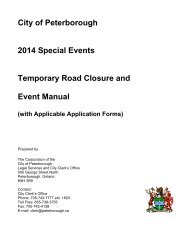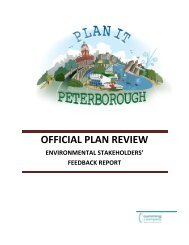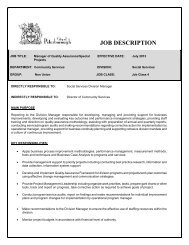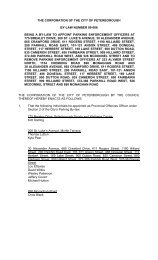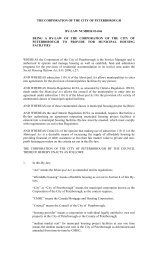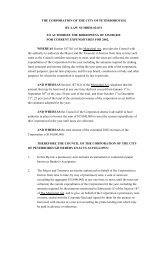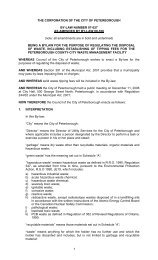Lower Byersville Creek Flood-Risk Mapping Update - City of ...
Lower Byersville Creek Flood-Risk Mapping Update - City of ...
Lower Byersville Creek Flood-Risk Mapping Update - City of ...
- No tags were found...
Create successful ePaper yourself
Turn your PDF publications into a flip-book with our unique Google optimized e-Paper software.
<strong>City</strong> <strong>of</strong> Peterborough<strong>Lower</strong> <strong>Byersville</strong> <strong>Creek</strong> <strong>Flood</strong>-<strong>Risk</strong> <strong>Mapping</strong> <strong>Update</strong>RESULTS OF ANALYSISculverts and the rail embankment from the flow routing model would not have anysubstantial effect on peak flows along the main channel <strong>of</strong> <strong>Byersville</strong> <strong>Creek</strong>, sincethere is no significant flow attenuation by the channel storage created by the back-upbehind the rail embankment. This can be seen by reviewing the peak flood flowvalues above and below the CPR rail line as tabulated in Appendix D. On this basis,it was not considered warranted to model the main stem flows with the CPR culvertsremoved or washed out as happened during the July 2004 event. With respect to thecomputation <strong>of</strong> water surface elevation using HEC-RAS, the effect <strong>of</strong> the CPRembankment has been included, as required by the OMNR technical guidelines.3.2.3 <strong>Mapping</strong> <strong>of</strong> Surface <strong>Flood</strong>ing Using HEC-RAS: Existing SystemFigure 3.3 presents the mapping <strong>of</strong> estimated surface flooding for the RegionalStorm ("Timmins") event, as determined from the water surface elevation computedby the HEC-RAS model using peak flows from the PCSWMM2005 model.Note that Figure 3.3 is for the existing system without any modifications to existingculverts.As was done for the July 2004 event, the mapping <strong>of</strong> the surface flooding areas hasbeen carried out using the DEM supplied by the <strong>City</strong>, with the general procedure asdescribed above.Some points to note about the mapping shown on Figure 3.3.• To map the full spatial extent <strong>of</strong> flooding, computed water surface elevations ateach modelled cross-section have been projected laterally along the section linesshown on the map figure.• These projections across the DEM did in some areas result initially in surfaceflooding or ponding within isolated patches or pockets that in all likelihoodwould not in fact experience such flooding, because there is no known orapparent hydraulic connection to the floodway. Some judgment and editing wastherefore necessary to develop the mapping as shown.• Similarly, because <strong>of</strong> the presence <strong>of</strong> multiple flow paths and the fact that themain stem and Examiner Ditch flow paths go through near 90-degree turns, therewas a requirement for some interpretation and judgment in mapping the floodsurface where cross-sections from the separate HEC-RAS models overlap or areorthogonal to one another.Along the eastern limit <strong>of</strong> the mapped area, the flood surface from the ExaminerDitch has been projected eastward to Erskine Avenue, and then further eastward ontothe Lansdowne Place property. This reflects a flood surface elevation in the range<strong>of</strong> 192.92 m to 193.02 m along the Examiner Ditch between The Kingsway and TheQueensway, and a low road surface elevation <strong>of</strong> 192.54 m along a sag in ErskineAvenue just south <strong>of</strong> The Kingsway. In other words, the mapping <strong>of</strong> surfaceflooding extending to the east <strong>of</strong> Erskine Avenue is based on lateral spread <strong>of</strong> flood3-2087-09-01/R_3-04108226_<strong>Byersville</strong> <strong>Creek</strong> <strong>Mapping</strong> <strong>Update</strong> 3-608/11/10






